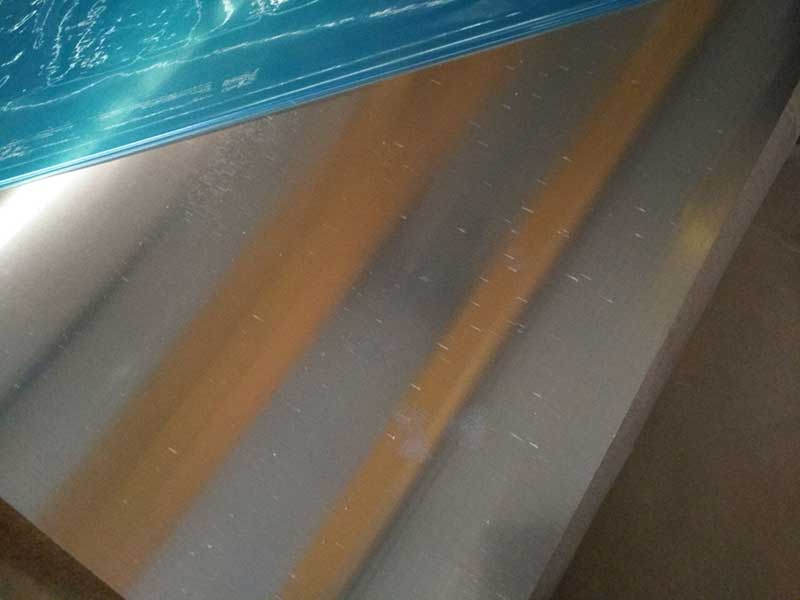Aluminium Sheet for Aircraft alloy 5052 5754 5083
The aviation industry continually pushes materials to their limits—demanding a balance of lightweight, strength, corrosion resistance, and formability. Aluminum sheets have long been central to this evolution, particularly alloys in the 5xxx series, specifically 5052, 5754, and 5083. Though commonly grouped together as marine- or corrosion-resistant alloys, it is their distinctive technical attributes and nuanced performances in aerospace environments that make each alloy's application uniquely valuable.
the Family: Alloy Composition and Basic Metallurgy
| Alloy | Elements (wt%) | Density (g/cm³) | Melting Point (°C) | Standard Temper Conditions |
|---|---|---|---|---|
| 5052 | Al Balances, Mg 2.5%, Cr 0.25%, Mn 0.1%, Others ≤ 0.4% | 2.68 | 607-650 | H32 (strain-hardened, partial annealing) |
| 5754 | Al Balances, Mg 3.0-4.0%, Mn ≤0.5%, Si 0.4% max | 2.68 | 615-650 | H22 (strain-hardened, partial annealing) |
| 5083 | Al Balances, Mg 4.0-4.9%, Mn 0.4-1.0%, Cr 0.05-0.25% | 2.66 | 582-652 | H321 (strain-hardened, stabilized) |
Distinctive beginners: The crystal lattice discrepancies attributed to the proportional variation in magnesium and trace elements scaffold critical enhancements in strength (via solid solution strengthening), forming capability, and heightened corrosion resilience in humid differentials nominal to aircraft environments.
Unveiling Technical Features With Aerospace Lenses
Alloy 5052
5052 stands distinguished for its excellent weldability, moderate tensile strength (~228 MPa in H32 temper), and exceptional resistance to marine atmospheric conditions. It stabilizes Al matrix with chromium improving strain hardening limits while deterring excessive grain boundary embrittlement.
Working with 5052, 5754, and 5083 aluminum alloys for aircraft sheet presents unique challenges compared to other applications. The stringent quality control demanded by aerospace necessitates meticulous attention to surface finish, consistent gauge, and absolute freedom from defects like inclusions or inconsistencies in the temper. We often see rejections due to subtle variations in the material's properties that might be acceptable in other industries, highlighting the crucial need for advanced testing and traceability throughout the production process. For example, maintaining consistent tensile strength and elongation across large sheet sizes is critical for structural integrity, and we’ve found that slight variations in the heat treatment can significantly impact these parameters. Furthermore, the need for specific corrosion resistance properties, especially in saltwater environments, requires careful monitoring of alloy composition and surface treatments.
Beyond the material itself, the fabrication processes present their own set of hurdles. Forming these alloys, particularly in complex geometries, requires specialized tooling and precise control over parameters like bending radius and forming speed to prevent cracking or work hardening. We've observed that improper handling during storage or transportation can lead to surface damage, necessitating extra care and potentially costly rework. Welding these alloys also presents particular difficulties, requiring specialized techniques and filler materials to ensure structural integrity and avoid porosity or cracking. the nuances of each alloy, and selecting the appropriate processes based on the specific aircraft component, is critical to achieving the required performance and durability standards.
Feature Axis:
- Moderate strength balanced with deep-drawing capability make 5052 optimal for aircraft internal panel stiffeners and avionics enclosures.
- Superior fatigue behavior complements deterring cyclic stress fractures crucial in slightly load-bearing non-structural frames.
Alloy 5754
5754 occupies a niche in higher mechanical priority composites attached to aircraft structures. With magnesium content averaging 3.4%, boasting ultimate tensile strength around 275 MPa in H22 temper, it offers stable elevated operational viscosity for aircraft skin where formability synergizes ultimate corrosion protection.
Feature Axis:
- Popular as clearance stiffeners, internal floor panels, and cargo linings.
- Outstanding performance conserving weight demands using moderate work hardening parameters outlined in AMS specifications, preserving integrity against stratospheric oxidation cycles.
Alloy 5083
Known for tactical-strength, 5083 intensifies mechanical robustness to UTS near 317 MPa at H321 temper, intensely beneficial in corrosive stress zones or load-intensive fuselage frame collars.
Feature Axis:
- Aerospace frames in sections exposed to marine boundary invite 5083 for state-of-art mixing of permanent setting resistances.
- Not scintillating but capable fighter for limited hardened rivets placements: where plane fuselage requires sure-footed against stress-corrosion effects in salt/brackish environments.
Tempering Conditions: Ratio Between Forming and Final Stability
- H32 Temper (5052): Work hardened with a degree of annealing partially reviving ductility post-forging. Makes sheets readily back-thin compared to full-streisand cracks across their form area surfaces.
- H22 (5754): Lower strain-hardened subtracts some brittle strain, boosting forming length wear rate in checked assemblies.
- H321 (5083): Stabilized heat treatment to lock Mg at grain boundaries inhibited creep aging: fundamentals to extended stress-disruption aviation zones.
These heat treatments consider preventions ranged in ASTM-B209 designations employed as action guides during aircraft sheet forming and rapid fabrication IDEA routes.
| Application Aspect | Alloy 5052 | Alloy 5754 | Alloy 5083 |
|---|---|---|---|
| Aircraft Internal Parts | Access panels, airflow ducts | Bulkheads, flooringHere | Reinforced structural brackets |
| External Aircraft Surfaces | Secondary wing skins, fairings | Wing trailing edges, fairings | Frame joint reinforcements, pirates’ patches |
| Environmental Excellence | Superior performance in humid/hot ground climates | Withstands humidity-& UV-low spectrum ranges | Rugged marine and salt-laced airfields zones |
| Fatigue Resistance Priority | Low middle-fatigue lifespan | Moderate | High-transition stress lives |
| Weight Efficiency Considered | Light but less ultra-strong structure nodes | Meeting economic aerospace margins | Dimensional heavyweight load nodes |
Crafting layers of nature’s aircraft components demand simulation by lifecycle monitoring based on the thermomechanical cyclic data researched explicitly by governing bodies like SAE and Airbus Standards.
https://www.al-sale.com/a/aluminium-sheet-for-aircraft-alloy-5052-5754-5083.html






